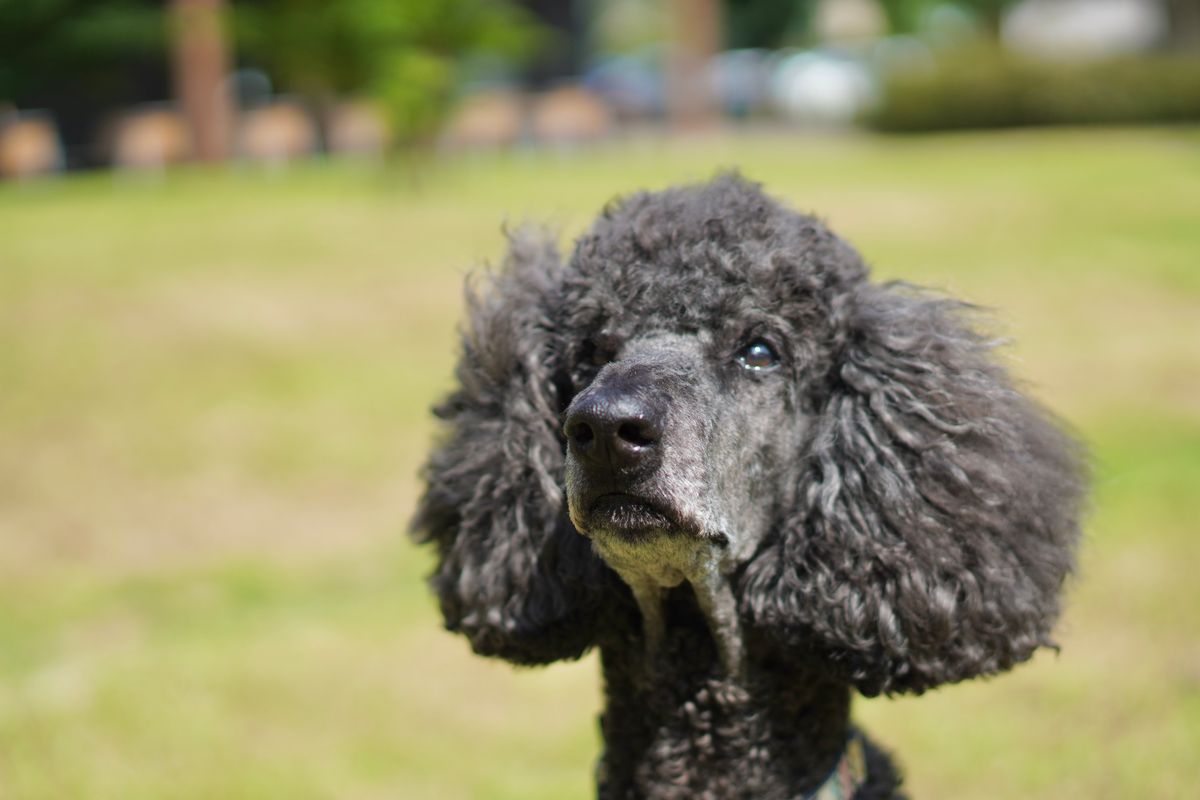ABOVE: © ISTOCK.COM, KSENIA RAYKOVA
When a person is overcome with emotion, their feelings stream down their cheeks. Even positive emotions can turn on the waterworks, as people bawl when they win awards, express love for their partners, or are reunited with a long-lost friend.
But these feelings-driven tears may not be a wholly human experience. Dogs can also cry happy tears, according to a study published today (August 22) in Current Biology. Although the animals’ eyes don’t overflow, they well up when they’re reunited with their owners after spending even just hours apart, the researchers found. And they have hunch as to why: a sudden increase in oxytocin, the so-called love hormone, named for its predominant roles in social bonding.
“I thought it was a fantastic paper . . . ingenious,” says Lori Kogan, a psychologist at Colorado State University who wasn’t involved with the work—though she adds that the study is “very preliminary.” Kogan, whose research focuses on human-animal interactions and who has previously studied oxytocin dynamics in dog owners, says the findings align with both her professional and personal experiences with the animals. “What all of us who are dog owners know is that dogs are really, really happy to see us when we’re reunited,” she says.
Tearful reunions
A few years ago, Takefumi Kikusui’s standard poodle Jasmine had just become a mom. As the dog was nursing her pups, Kikusui—an animal behavior researcher in the School of Veterinary Medicine at Azabu University in Japan—noticed something unusual: “She had teary eyes,” he recalls in an email to The Scientist. “So that gave me the idea that oxytocin might increase tears. Oxytocin, as you know, is the maternal hormone,” produced at high levels in female mammals when giving birth and lactating.

Kikusui’s group and others had previously found that pet dogs exhibit an increase in oxytocin levels when they interact with their owners. Kikusui says he and his team hypothesized that reuniting with their owner after a prolonged period apart “would be [an] emotional event to dogs,” marked by tear production and an underlying surge in oxytocin.
To test the idea, the researchers separated pups from their owners for several hours before letting the pairs reunite. Five to seven minutes into their reunion, the scientists performed a Schirmer tear test on the dogs to measure how teary their eyes had become. They then compared the results with tear production that occurred when the dogs were similarly separated from and then reunited with someone they knew but who wasn’t their owner. The animals’ eyes did, indeed, well up with tears upon reconnecting with their owners—significantly more so than when they reunified with their human acquaintance.
To explore whether oxytocin could be driving an increase in tear production, Kikusui and colleagues applied a solution of the hormone to the dogs’ eyes. As hypothesized, oxytocin application significantly increased tear volume, while applying a control solution containing another peptide made from the same amino acids did not.
Ad Vingerhoets, a psychologist at Tilburg University in The Netherlands who has long studied the links between emotions and tear production (and even authored a book titled Why Only Humans Weep), says the idea of oxytocin mediating tear production makes sense. While the mechanisms underlying emotional tear production aren’t well understood, some have suggested that prolactin—a hormone often physiologically associated with oxytocin—plays a role in tearing. And anecdotally, Vingerhoets recalls the titular scene from the 2004 documentary The Story of the Weeping Camel, in which a female camel that had initially rejected her calf finally allows it to suckle as tears stream from her eyes. So, he says, perhaps nonhuman animals can weep after all.
Does your dog love you?
Vingerhoets says what struck him most about the paper was that Kikusui and colleagues looked for—and found—so-called tears of joy. Most of the research on emotional tearing examines crying that accompanies negative feelings, he says. That’s in part because, even in people, tears associated with positive emotions are mysterious. So for the team to have found evidence for tears associated with a positive experience—“this especially makes it very remarkable for me,” he says.
Follow up research could look at tear production under less happy circumstances, Vingerhoets says. “Loss and separation, homesickness heartache, bereavement . . . those are the situations that we consider as the strongest elicitors of tears,” he notes. “For me, it will be interesting to see whether [negative experiences] are also accompanied by increased tear production” in dogs.
For Kikusui, there are plenty of questions left to explore. In humans, and particularly in adults, the primary functions of emotional tears are thought to be social: to elicit sympathy and empathy, for example, or to encourage helpful behaviors in others. Dog tears could be similar—or not. “We do not yet know if dogs show an increase of tear[s] during dog-dog reunion[s],” he writes. “We also do not know how dogs use tears [to] communicate with each other. We need to clarify the social function of dog tears.”
Asmir Gračanin, a psychologist at the University of Rijeka in Croatia who was not involved in the work, says it’s possible that dogs only cry for us. “They coevolved with humans,” he notes, adding that “if I would have to choose among all different species of mammals, I would definitely look into dog's behavior to look for if there is some kind of special communication [with humans].”
Kogan agrees, though she suspects dogs are not completely alone. “We have shaped dogs to a greater degree than any other animal . . . so perhaps, it’s going to be easier to detect in dogs,” she says. “But I think that we probably would find similar things in cats . . . and I think the same thing with equines. So these animals that we have a very long-standing relationship with, I think there’s a good chance that we would see something similar.”

However, having such a special relationship with humans opens the possibility that dog tears actually aren’t emotionally driven, Gračanin says. Instead, they could just be a physiological phenomenon—one that capitalizes on a social signal already present in humans and was therefore artificially selected for.
See “Catch My Drift?”
“Dogs are really, really susceptible to new adaptations,” both physically and behaviorally, Gračanin notes. Because tears universally elicit prosocial behaviors in people, it’s not hard to imagine how tear-prone pups might have received more care than their less tearful littermates. Indeed, in the new study, Kikusui and colleagues found that people rated pictures of dogs given artificial tears as cuter. So Gračanin says that over time, the people that domesticated dogs may have unintentionally bred them to cry, much like they selected for dogs’ mobile eyebrows.
This scenario doesn’t guarantee that the tears are emotionless. “We come to the question: What is an emotion?” says Gračanin. Do dogs feel the physiological changes we associate with happiness as humans do? In other words, is your dog really happy to see you, or is he simply going through biological motions hardwired by thousands of years of selective breeding?
The latter possibility could have intriguing evolutionary implications, as it might hint at how human emotions arose, Gračanin notes. He says that even if humans are unique experiencing crying-related emotions, our feelings and how we express them still had to come from something. Perhaps, in tearful dogs, we’re witnessing an initially unemotional behavior in the process of becoming emotional as it’s exaggerated by selection—a “transitory behavior that could maybe one day become a real emotional signal.”
Then again, if dogs really are overcome with joy, their tears could add to a growing body of evidence that no hard lines exist between humans and nonhuman animals, says Kogan. “Like a lot of other things that we’re dispelling over time that we think humans are totally unique in, it’s just one more thing that no, we’re not.”
Like this article? You might also enjoy our Life newsletter, which is filled with stories like it. You can sign up for free here. |








